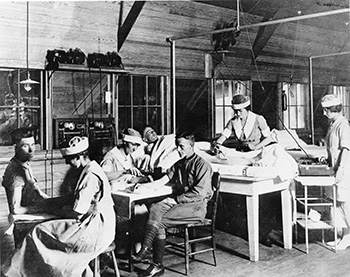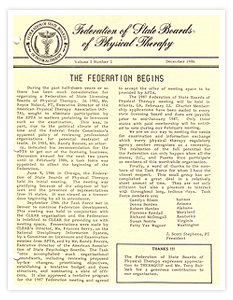Physical therapy has been around for ages, but practicing therapy as a career is relatively new. Keep reading for a brief overview of the history of physical therapy: from war-time treatment and statewide standardization to the growing career it is today!
Overview of Physical Therapy
Physical therapy is a branch of healthcare specializing in rehabilitative practices to strengthen muscles, restructure posture, and improve overall well-being. Therapists assess and diagnose various injuries and mobility issues and serve as the primary treatment provider in physical rehabilitation.
When treating a patient, PTs choose from a wide range of therapies, with movement therapy or “therapeutic exercise” among the most typical. Pain-relieving strategies can include massage, heat therapy (thermotherapy), cold therapy (cryotherapy), and electronic stimulation. Therapists also use neuro-muscular re-education techniques to help the patient relearn patterns of physical behavior and prevent recurring injury or pain.
Some of these treatments are as old as physical therapy itself, while other treatments require the latest equipment in rehabilitative healthcare. Thus, a physical therapist is not only well-educated in the administration of these diverse therapies, he or she can create a comprehensive treatment plan astutely designed for each patient’s needs.
Ancient History of Physical Therapy
The ancient Greek, Roman, and Egyptian civilizations provide the roots for some physical therapy treatments still used today. The movement therapy for which physical therapy is most well-known is thought to have come from Asia. The Tao-Tse people of ancient China record some of the earliest instances of “Cong Fu” therapeutic movement in 3000 BCE. By 500 BCE in ancient Greece, physician Herodicus was prescribing manual therapy and exercise to treat pain and disease. The second-century Roman physician Galen reportedly used gymnastics, or movement exercises, to rehabilitate wounded soldiers in the Roman empire.
In a similar manner, ancestors of massage therapy, cryotherapy, and thermatherapy are traced to ancient, unrecorded histories. For instance, hydrotherapy, or movement treatment in water, was a popular healing treatment in ancient Japan and China; Hippocrates also recommended hydrotherapy for fellow Greeks in the 4th century BCE. All these records indicate that, while the techniques of physical therapy may have changed, the results are time-tested throughout millenia.
Modern History
Modern physical therapy practices as we recognize them today began taking shape in the 18th century following the development of orthopedics. Sweden was the pioneering country to institute physical education with its Royal Central Institute for Gymnastics. In 1887, Sweden’s National Board of Health and Wealthfare recognized “physiotherapy,” a universal term for physical therapy, as a viable health practice. Nearby countries such as England and Denmark followed suit, establishing physiotherapy as a valid treatment for ill and injured patients.
In America, physiotherapy came into practice by way of the Reconstruction aides of 1918. Trained by General William C. Gorgas at Reed College, these 18 women administered massage and exercise therapy to the injured troops of World War I. Their formal education was brief by today’s standards – only four months long – but reflected the latest physiotherapy practices in Europe. After successfully rehabilitating soldiers, Mary McMillan and the majority of her fellow aides founded the American Women’s Physical Therapeutic Association in 1921.
National and International Growth
Mary McMillan’s therapeutic association is still operational today under the name American Physical Therapy Association, or APTA, which celebrates its centennial anniversary this year. The name was changed in 1947 to better reflect the diversity of the growing membership of physical therapists.

Source: world.physio/history
Ever since its founding, APTA has advocated for honest and effective methods in therapy practice. Their scientific journal PT Review, now called Physical Therapy Journal, began circulating in 1921 to institute standards for peer-reviewed research in physical therapy. Additionally, APTA provides PTs innumerable resources for career advancement, including specialist certification and access to a vast PT network. APTA represents over 100,000 physical therapists today, nearly half of the 250,000+ working across the country.
Physiotherapy is not only time-tested, it’s universally beneficial. The World Physiotherapy organization reports over 660,000 practicing physiotherapists throughout the world today. The WPT began in 1951 as a coalition among 11 international physical therapy associations, including APTA. Older members include the Canadian Physiotherapy Association, founded in 1920, and the Association of Danish Physiotherapists, established in 1918. WPT supports its member organizations through advocacy, shared learning, and international conferencing.
Physical Therapy’s Military History

Physical therapy has sustained a long history with the military, from its incipient beginnings under the touch of the Reconstruction aides to its current program collaborations.
The Army of Medical Excellence instituted an early physical therapy program in 1922 in order to fuel the work of the Reconstruction aides. This course, originally set at Walter Reed General hospital, ran only four months long. By 1928, the course had undergone necessary changes and adjustments to earn accreditation as an official physical therapy program.
By 1942, it was possible for physical therapists to join the military and seek commissions for completed PT programs. Eventually, a direct military application for physical therapy education became available in the Army-Baylor program at Baylor University in 1971.
Physiotherapists continue to play invaluable roles in both civilian and military settings, serving stateside and accompanying troops in every major conflict since World War II.
History of Physical Therapy Accreditation
Outside of the military, PT degree programs began appearing all over the US in the late 1920s. Among the oldest physical therapy schools still in operation today are Northwestern University, University of Pittsburgh and New York University. In 1928, Northwestern became the first university to operate a fully-accredited physical therapy program.
With such widespread practice, physical therapy needed standardization. Medical research and innovation require that programs not only know but also comply with best practices.
In order to assure PT students of a high-quality, sufficient education, schools seek accreditation from varied third-party educational agencies. An entry-level PT program earns accreditation by undergoing peer review, complying with required standards, and submitting program reports. Today, over 220 PT programs are accredited by the Commission on Accreditation in Physical Therapy Education (CAPTE), which has been the sole accreditation agency for physical therapy since 1983.
Physical Therapy Licensing Requirements
Since the early 1950s, aspiring therapists have undergone a test to show competency in clinical science and therapy procedure. Today, graduates of accredited physical therapy programs must pass the National Physical Therapy Examination, a rigorous boards exam administered by the Federation of State Boards for Physical Therapy (FSBPT).

Although APTA originally administered the exam, in the mid 1980s they sought out an impartial, third-party organization to take it over. Since 2003, all 50 states have established unique licensing requirements; the purpose of the FSBPT is to issue a boards exam reflective of the varied licensing requirements across the country. The only major change to physical therapy credentials in the last decade is the 2016 requirement that all entry-level PTs earn a Doctorate of Physical Therapy.
As research yields new findings and better practices in physical science, the career grows and flexes. In order to keep their licensing up to date, thousands of practicing physical therapists undergo continuing education classes each year.
Physical Therapy Today
Physical therapists today benefit from a long-established history of rehabilitating injury, soothing pain, and improving general well-being. Although the credentials to practice physical therapy have become more rigorous over time, the result is a career more effective – and in more demand – than ever before. The opportunities for research, continuing education, and professional specialization make a career in physical therapy robust and rewarding.
For more information on how to become a physical therapist, check out this comprehensive, step-by-step guide.
This blog also contains resources for practicing PTs, including license renewal requirements, continuing education advice, and physical therapy documentation templates.

This article was written by Naomi Benecasa, a cellist with a Bachelor’s in Music Performance and a Master’s in Music Psychology. Fascinated by fitness and fermentation, she provides copywriting and editing services for PTProgress from her home in New York.


